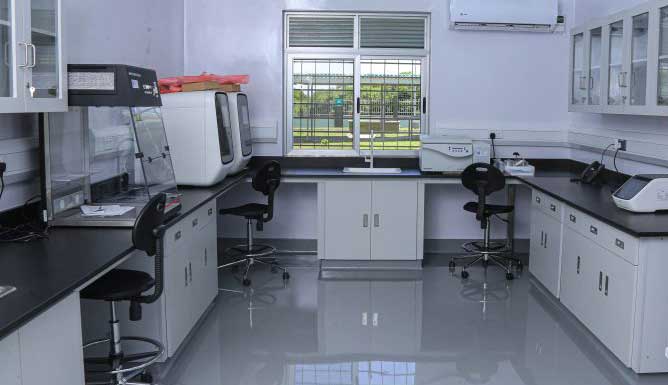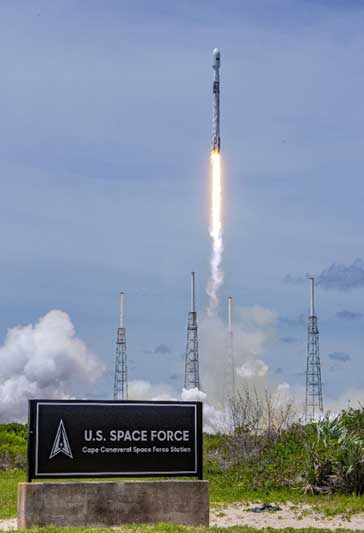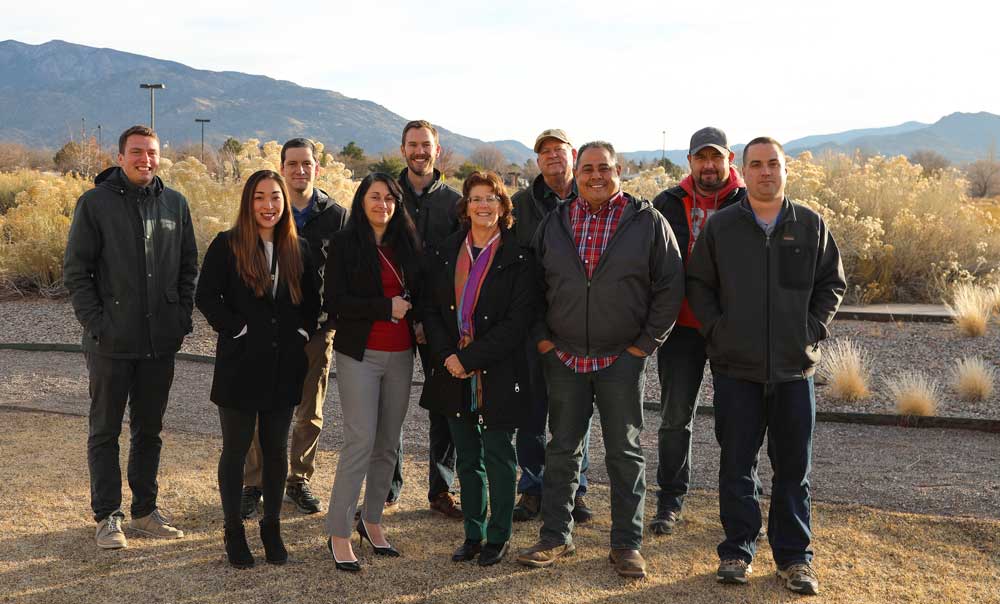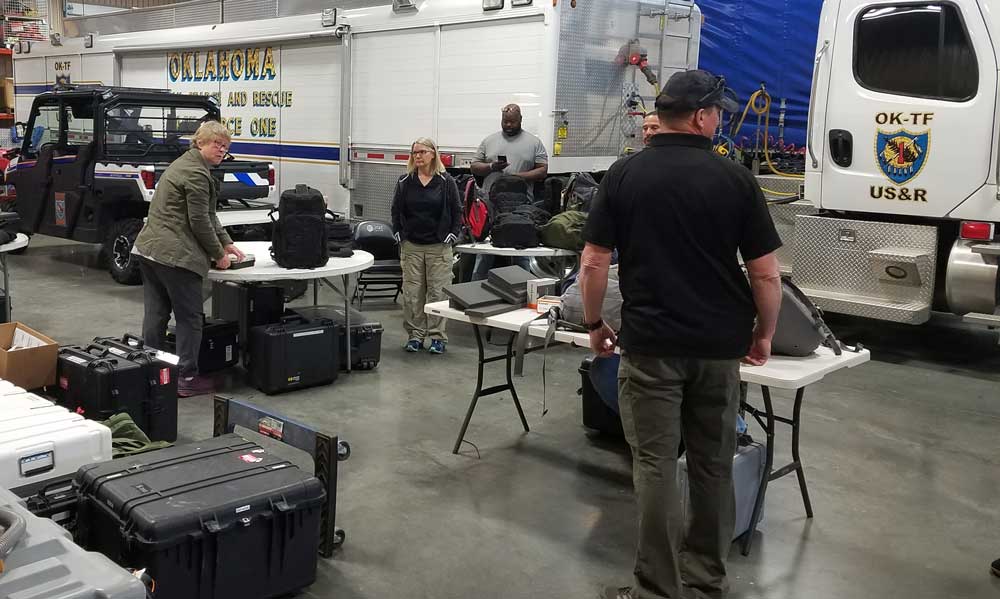
Assessing US and Mexico border security
Sandia partnered with the Department of State’s Bureau of International Narcotics and Law Enforcement Affairs and Mexico’s Servicio de Administración Tributaria to evaluate security in five border sectors, each with multiple points of entry. Used to develop a baseline analysis of existing security operations, these assessments will inform recommendations for future U.S. and Mexican strategic investments that disrupt illicit cross-border activities and potentially guide other international cross-border security activities. (5000, 6000)
Security System of the Future roadmap
Fundamental architectures for physical security systems that protect the nation’s most critical assets have not changed much since Sandia created the key principles for these systems five decades ago. They are heavily reliant on costly infrastructure that limits adaptability and adoption of rapidly improving capabilities. Sandia’s Security System of the Future Program is a phased approach for developing the next generation of physical security systems, aiming at simultaneously decreasing installation costs, improving target detection and increasing system resiliency. Several U.S. agencies have invested in the development of an integrated Security System of the Future roadmap using many capabilities from across Sandia. (6000)
Unmanned Aircraft Systems Research and Engineering Center established
Recognizing the rapidly evolving risk to national security driven by extensive development of unmanned aircraft systems, the DOE and NNSA requested Sandia establish and lead the UAS Research and Engineering Center. Leveraging expertise from partners across the national security enterprise, the center addresses the challenging problems resulting from the adversarial use of these technologies. Chartered in January 2021, the center’s early efforts have included advising the White House Office of Science and Technology Policy on the use of foreign-sourced unmanned aircraft systems for critical national security missions. (6000)

Monitoring global nuclear weapons testing activity
Sandia provided software updates that will improve the Comprehensive Nuclear-Test-Ban Treaty Organization’s ability to filter the information processed daily to monitor for global nuclear detonations. Data is gathered at more than 300 monitoring stations and sent to the organization’s International Data Centre, where signals in the data stream from natural and human-caused activities, including earthquakes, volcanic eruptions, mining and drilling, nuclear reactor operations and medical isotope production create noise that complicates identifying nuclear detonation events. Sandia’s updates sustain the highly sensitive monitoring system that is essential for nuclear weapon treaty verification efforts. (6000)
Novel electric field sensor advances noninvasive diagnostics of electronics
Sandia modeled and developed a novel laser-based method to improve electric-field detection signal-to-noise ratio by at least an order of magnitude. This technology allows for the sensitive detection of the charge state of electronic devices, such as capacitors, and could enable end users to examine sealed objects to determine potential hazards. The work advanced research initially funded by Laboratory Directed Research and Development from technology readiness levels one and two to level four. (6000, LDRD)
Global Burst Detection test assets mitigate program risks
The Global Burst Detection team continued to execute in accordance with an accelerated test asset delivery schedule to support the U.S. Space Force’s risk-mitigation approach for the GPS IIIF program, exceeding original NNSA delivery expectations. On-schedule test-asset shipments include Global Burst Detection Simulators 1 and 2 in May 2021 and the Interface Emulator in July 2021. These test assets will be used by the Space Force and supporting contractors for Global Burst Detection-to-GPS space vehicle compatibility testing. (6000)

Increasing biological security in Uganda
Sandia’s Global Chemical and Biological Security team partnered with the Uganda Wildlife Authority to complete a final operational readiness assessment before it could assume control of the Wildlife Veterinary Diagnostic Laboratory, a state-of-the-art zoonotic diagnostic facility funded by the Defense Threat Reduction Agency. Building on past Sandia biorisk management training, the authority was well prepared for the exercise and demonstrated rigorous measures to ensure laboratory biosecurity. The facility will continue to support the authority’s disease detection, prevention and research mission. (6000)
Rebuild of Djibouti radiological detection system
After floods destroyed key parts of a radiation detection system in Djibouti, Sandia border security experts worked quickly to preconfigure, build, test and ship an entire multitechnology radiation detection system to replace damaged infrastructure. The team also developed new procedures to provide virtual oversight for installation and final acceptance of the system, which plays a key role in combating radiological and nuclear material smuggling in Africa and the Middle East. (6000)
Cooperative scientific engagement for global security
Sandia’s Cooperative Monitoring Center reinvigorated its mission to increase global security through science-based collaboration by hosting dialogues with key stakeholders in government, academia and industry on issues at the intersection of technology and policy. Activities included the Global Climate Security Symposium, the Nuclear Energy Experts Group roundtable on civil nuclear energy, a four-panel series on cooperative security in South Asia and 20 expert-driven regional seminars. The center also hosted seven visiting research scholars from five countries to conduct and publish new research on regional security issues. (6000)

Global Burst Detector III Payload launched
On June 17, 2021 the U.S. Space Force launched the fifth Block III GPS satellite onboard a SpaceX Falcon 9 rocket. The satellite is equipped with a Global Burst Detector III payload built by Sandia’s Monitoring Systems Center in partnership with Los Alamos National Laboratory. The detector enhances the nation’s capability to effectively monitor for nuclear detonations and compliance with treaties. (6000, LANL)
Nuclear safeguards technology transfer wins awards
Sandia’s Global Nuclear Security and Non-Proliferation team was presented two prestigious International Safeguards Engagement Program Joule Awards for outstanding efforts in the transfer of nuclear safeguards technologies. The team was recognized for facilitating the transfer of identiFINDER, a handheld sodium iodide detector tool that enables users to identify and characterize nuclear materials, from the NNSA to the Mongolian Nuclear Regulatory Authority. The team also was recognized for deploying Sandia-developed software designed to increase surveillance system efficiency to the International Atomic Energy Agency Department of Safeguards. (6000)
RAPTR N95 delivers a reusable, affordable respirator
Recognizing a need for affordable, effective N95 masks during the COVID-19 pandemic, a team of Sandians developed an affordable, rapidly producible, effective N95 respirator mask design. The team prototyped the mask and verified its effectiveness in comfort, ease of breathing, filtering ability and ease of sterilization. The project was selected as an R&D 100 winner for 2021 in two categories: Analytical/Test and Special Recognition Corporate Responsibility, Silver Medal. (1000, 2000, 3000, 5000, 6000)
First hypertemporal sensor focal plane array
The Global Burst Detector team successfully completed design, fabrication and realization of the first hypertemporal sensor focal plane array. A key component for optical remote sensing missions, the focal plane is a multichip assembly that relies on several industry partners and advanced microfabrication and assembly processes to achieve a functional integrated product. The focal plane is capable of recording events of interest at multiple kilohertz rates to measure key event characteristics. (6000)

Access-delay hardware transferred to industry
NNSA’s Office of Radiological Security funded Sandia’s successful collaboration with Gamma Service Medical to develop access-delay and tamper-detection hardware for about 125 blood irradiators containing cesium-137 distributed worldwide. A factor of 4 improvement in delay time was achieved to meet security requirements to prevent illicit removal of radioactive materials from these devices. Test results were published in internal Sandia reports, and the designs were transferred to industry for use on existing and newly manufactured machines. (6000)

Radiological Assistance Program real-world responses
Sandia’s Radiological Assistance Program team members supported and responded to several real-world events. A responder was part of the 29-person cross-complex team that performed nuclear and radiological vehicle scanning for the presidential inauguration. The program also supported the Environmental Protection Agency’s search of a facility in Davis, Oklahoma, the FBI investigation of an individual suspected of collecting radiological material and mobile search operations at the Tulsa Race Massacre Centennial commemoration and presidential visit. (6000)
Correction: An entry about the Office of Radiological Security funding Sandia’s collaboration with Gamma Service Medical misstated the improvement in delay time. The time was improved by “a factor of 4 improvement,” not “reduced by 75%.”